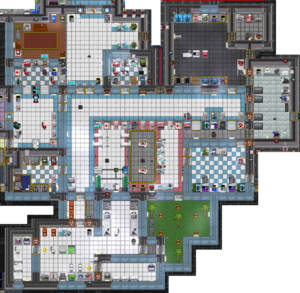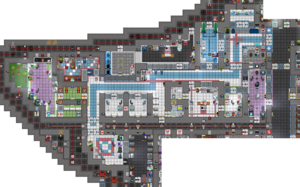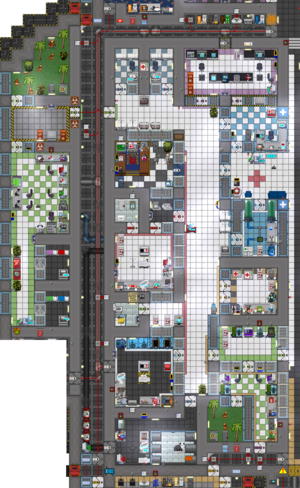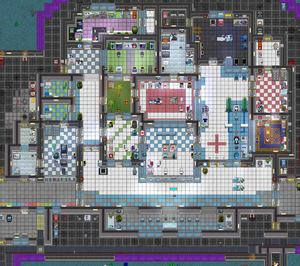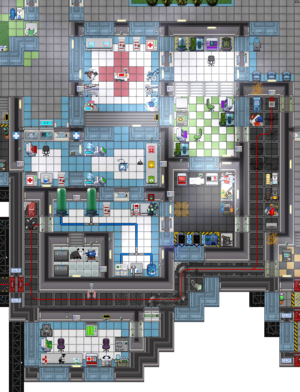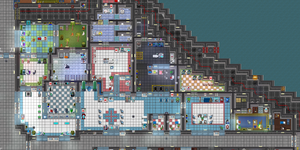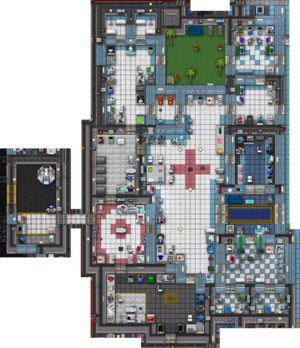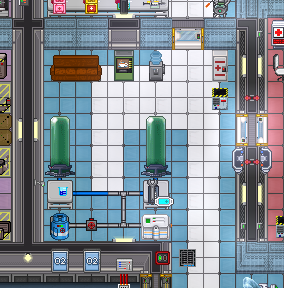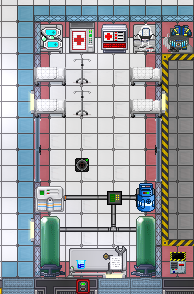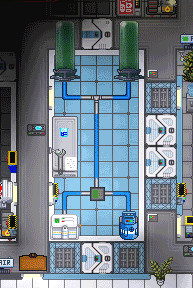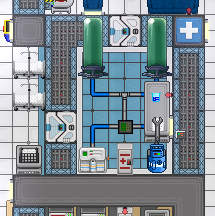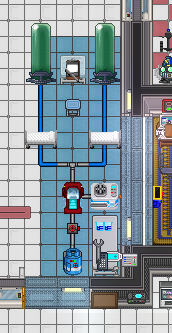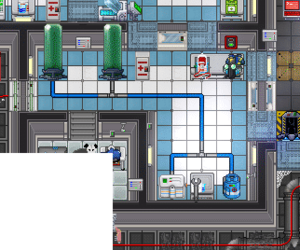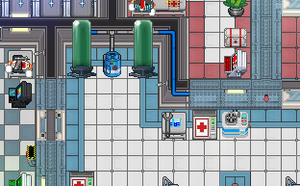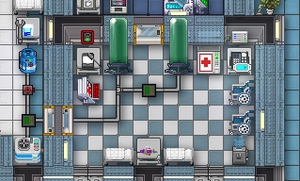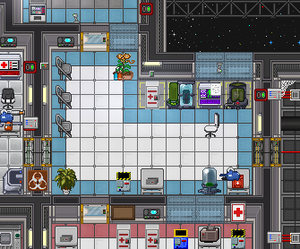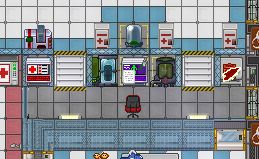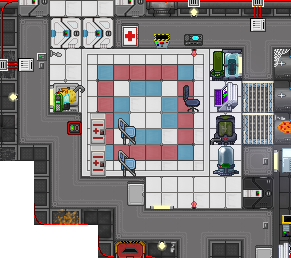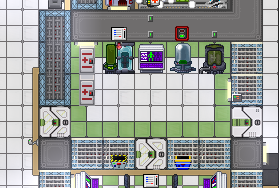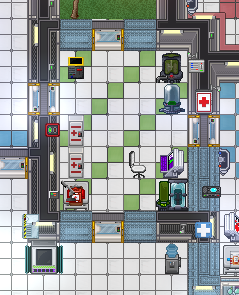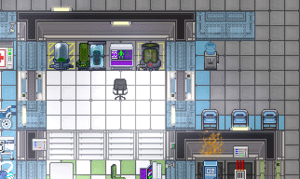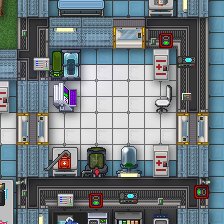Medical Doctor
| MEDICAL DEPARTMENT | |
|---|---|
| Medical Doctor | |
 Medical Doctor |
Difficulty: Medium Requirements: None Access Level: Medbay, Morgue, Pathology, Maintenance Additional Roleplay Access Level: None Supervisors: Medical Director, Captain Subordinates: None Responsibilities: Treat sick and injured crew members, bring dead ones back to life through cloning and other means Guides: Chemicals, Chemistry, Doctoring, Decomposition, Medical Objects, Virus |
Easily identified by their starting labcoat and cool red and white jumpsuit, Medical Doctors treat the crew's sick and injured and attempt to revive its dead. Some doctors roam the halls as paramedics, while some stay in Medbay and take on any incoming patients. All are expected to have a good grasp of the various types of damage and common ailments, the appropriate medicines and surgeries for treating them, and the procedures for cloning the dead, or at least the ability to scream at the Geneticists or Roboticists to handle said dead for them, that you can use by typing:
say :m Can you borg this body? They can't be cloned.
Being a doctor in Space Station 13 is easier than being one in real life, but perhaps just as stressful. SS13 is a dangerous place, and you can expect many patients dropping by, sometimes with lives at stake. Medbay is a frequent target of Antagonist activities, doctors are often put under unrealistic standards and expectations, and sometimes you just see the worst in people. Nevertheless, being able to save people's lives--including yours--through good Doctoring is immensely rewarding, highly worthwhile to learn, and invaluable for everyone.
Your Tools
Your lockers, NanoMed medical dispensers, and Port-A-NanoMed contain vital equipment needed to save lives.
Medicine
All these treatments are administered by simply clicking on the patient with the medical item in your active hand.
- Medical patches administer a lot of medicine over a few minutes. They're appropriate for patients who have a fair bit of damage but aren't dying or in critical condition (less than 0 health). You'll most commonly use patches in the form of styptic powder patches for cuts and bruises and silver sulfadiazine patches for burns. They're a little uncommon, and once they're used up, you have to make more with a CheMaster.
- Auto-menders apply either styptic powder, silver sulfadiazine, or synthflesh topically, adjusting the amount used to reduce wastage. You and the patient must be adjacent to each other. Suitable for treating both burns and bruises and good for both people with minor boo-boos and critically-injured people who need a lot of damage healed quickly. To refill it, click on it with a pill, reserve tank, or other container of medicine.
- Hyposprays automatically inject a set amount of chems into the patient, ideal for administering life-saving medicine in urgent situations, such as giving patients in heart failure epinephrine. However, by default, only certain chems can be inserted into the devices. You can have multiple chems in a hypospray and can refill it clicking on it with a pill, bottle, or other chem container.
- Pills are used for medicine that needs to be ingested in order to function, such as mutadone or salbutamol. The entire contents of the pill are put into the body upon ingestion, so they're good if the patient needs a moderate (roughly 20 units and over) dosage. If you're trying to swallow a pill yourself, you'll eat it immediately, but if you're making someone else swallow it, there's a few seconds of delay. For obvious reasons, you cannot reuse pills; instead, you must make more via a CheMaster.
- You can dissolve them in a beaker to withdraw medicine in a controlled manner, dispensing with a syringe or dropper.
- Similarly, syringes inject their contents into people 5 units a time. Because of the low capacity and administration method, it's best suited for medicines that heal internally and work best in small doses, such as calomel or charcoal. Like with pills, injection is instant if self-administered, but delayed if not. To refill a syringe, you must click on it in-hand to set it to draw, then click on a suitable container, such as a medicine bottle or reserve tank, with the syringe in your active hand. Don't forget to click on it in-hand again to set it to inject.
Other
- The reagent scanner and health analyzers are important diagnostic tools. There are separate hand-held devices, and every medical PDA includes app versions of them. Regular health analyzers can be upgraded to show the chemical reagents currently inside a patient (but not the reagents inside other things) - check the medical vending machines/dispensers. The PDA's functions are separate (medical scan is on by default), whereas analyzers have an unified readout. You may have to enable the upgrade manually after installing it.
- Medical belts store medical suppplies and are a godsend when working outside of medbay, as they are essentially a medkit you can wear around your waist. Uniquely, unlike many other belts, they can store defibrillators. Use them to your advantage.
- With a stable oxygen supply and the ability to dispense certain medicine such as saline, sleepers are decent to prevent further degeneration of a patient's health status and allow anyone to view the occupant's health. Sleepers can also be set to hibernation mode, keeping the occupant asleep while injecting them with rejuvenators automatically. If you have too many severely hurt patients to handle at once, you may want to stick some of the more stable ones in sleepers while you deal with the emergencies first. Sleepers can also be used to treat addictions, which are surprisingly common and hard to get rid of by other means.
- Health Monitor Implants and implanters/implant guns are not exactly healing tools but will make your job immensely easier by notifying your PDA of when and where the implantee is in critical condition or has died.
Medbay starts with a Head Surgeon. On any given round, there is a random chance that he will be a cardboard box or a medibot. If he's a bot, let him treat minor injuries in the medbay lobby.
Basic First Aid
Your health goggles show you condition of everyone around you at a glance, and if you aren't wearing a pair as a doctor, you deserve to be fed to the roboticist. Equipping your pair of ProDocs with a health analyzer upgrade (check the medical vending machines) is also a good idea, because it makes performing a complete health scan of anybody within a 4 tile radius simply by examining them possible. The various handily-color-coded icons are explained below:
| Icon | Health Level | Meaning |
|---|---|---|
| 100% | Perfectly fine. They can be on their way out now. | |
| 80-99% | Hurt, but bearable. Needs some Saline and perhaps a patch or pill. | |
| 60-80% | Needs some assistance. A quick pill or patch will do. | |
| 40-60% | Hurting for some healing. Better look into it. | |
| 20-40% | Terribly injured. Needs some serious assistance. | |
| 0-20% | Close to dying. Tend to them urgently! | |
| < 0% | Dying! Get out the atropine/epinephrine and treat them quickly! | |
| N/A | Dead. Resurrect them with robotics cloning, or chemistry. Check first though. | |
| N/A | Implanted with a Health Monitor implant. | |
| N/A | Implanted with a Cloner Monitor implant. | |
| N/A | Implanted with both a Health Monitor implant and a Cloner Monitor implant. |
Is the patient bleeding? Dress the wounds with bandages or suture, then check their blood level. If it's low, inject saline and use a blood bag on them.
Saline will help stabilize an injured person. Styptic powder works against brute damage and silver sulfadiazine against burns. Charcoal is effective to treat toxin damage. In case of suffocation, use a salbutamol pill. Scan your patient by using your PDA or health analyzer and administer the appropriate medicine.
People who have slipped into critical condition are at risk of falling into shock, cardiac failure or other terrible things and will die rapidly without treatment. CPR will help to keep them properly oxygenated and slow down the deterioration of their health. Just take off their mask and your own and target them with the Help intent. A patient who is thrown into cryo without being stabilized will take longer to heal and may die. In emergencies, an injection of epinephrine or atropine can help to rapidly resuscitate your patient, but don't overuse them!
Advanced Medicine
Between cryo, the various first aid kits and medibots, you have enough to treat most common ailments. For a more complex guide, check out Doctoring.
Using the Cryo Chambers
Setting Up the Cryo System
It's a good idea to invest a minute or two at the beginning of every round and start the cryogenic healing pod system, a machine that administers cryoxodone, a medicine with powerful healing properties at sub-zero temperatures. It's great at healing critically injured patients, but the cryo cells do require some setup to make full use of them. Make a habit of it.
- Pick up a wrench.
- Click on the O2 canister to connect it to the pipes.
- There should be two beakers of cryoxodone nearby. Pick up one at a time.
- Add one beaker to each cryo tube by clicking on it with the beaker.
- Set the freezer to the lowest possible temperature if necessary. To get the low temperatures needed for cryoxodone to heal, the cryo pods use cold gas to cool the patient down, which needs to be at 170 Kelvin or lower. It should be at its default value, 73.15 Kelvin. Flick the power switch and leave it on.
- (Optional) Add a health analyzer upgrade so you can view the reagents inside an occupant's bloodstream.
- (Optional) Add a defibrillator, so that the cryo cell can reverse cardiac failure and cure cardiac arrest. If you want to take the defib out for other uses or wind accidentally inserting it in, you can remove the defib simply by clicking on the cryo cell with a wrench, which is usually conveniently nearby.
Don't worry about the cryoxadone - it isn't used up unless there's someone inside the tube. If it does run out, you simply inject some in with a syringe or insert a fresh beaker of cryoxadone. However, leaving the chambers on causes a slow but constant gas leak. To avoid draining the O2 canister needlessly, leave the tubes off unless they're occupied.
It is also noteworthy that pure oxygen is not a requirement. Should you ever need to replace the gas supply, an air mix canister from emergency storage or the air hookups will work just as well.
Administering Cryomedicine
So, you have an emergency on your hand? Don't panic and follow this checklist:
- Stabilize the patient with CPR or stimulants.
- Check the cryo tube to see whether the gas temperature is still optimal.
- If the patient is wearing any type of exosuit (space suit, lab coat etc.) or headgear (mask, hat), remove them.
- Stuff the patient into an unoccupied tube and turn it on.
- If the cell is outfitted with a defibrillator, and the occupant is in cardiac failure or cardiac arrest, ZAP THEM!
- Monitor their recovery. Clicking on the cryo tube will pop up a window with the occupant's current health.
- Once they have fully recovered, the system will eject them automatically. Turn off the cryo tube at this time.
- Verify their status with your PDA or a health analyzer, especially if they had poison in their system or were suffering from heart failure.
To stress the point, it is important that you don't forget to strip your patient of exosuits and headgear. Their body temperature has to fall below a certain threshold, which is unlikely to happen if they still have said items on, or cryoxodone won't work. Plain and simple.
The Cloner
Sadly, you won't always be able to save the patient. This is where the cloning apparatus comes into the play, which was formally the geneticist's responsibility and is now open to all medical personnel.
To clone someone, simply go through the following steps:
- Use the Grab intent on the subject and then click on the scanner to load them in. You can also click-drag the subject's sprite onto the scanner's, which will make you do the previously mentioned steps but faster and automagically.
- Click on the Cloning console with an empty hand. Go to Records and click Scan at the top left. This step will (usually) add them to the Cloning Records, and will also give them a Cloner implant that ensures their record in the cloner updates. For a full health monitor implant that can send alerts and locations to your PDA, you will have to print those from the Medical or Robotics fabricators and implant them by hand.
- Go down to the Records section and find the person you want to clone.
- Click Clone to start the cloning process.
- Right-click the scanner and choose Eject to take them out of the scanner. You can also use the Eject verb from the Local tab, enter Eject into the command bar, or just click the scanner sprite.
Please note that you can scan bodies without a brain or even a head. Also, if someone comes in to get scanned of their own accord, they can climb in and jump out of the DNA scanner themselves. If someone has the initiative to come in and get scanned on their own, it is polite to attempt to clone them every 10-15 minutes. The one time it works you can be assured they were dead in a maintenance tunnel somewhere.
Once the cloning process starts, it normally takes about 2 minutes for it to complete. When a clone stumbles out, they are naked, and usually have some combination of toxin damage and brain damage. Charcoal and mannitol respectively will fix these problems. For increased efficiency, you can dissolve these chems directly into the cloning pod. For a very speedy cloning experience, additionally add potassium iodide and salicylic acid as well, or omnizine if you have access to it. Give them some new equipment from their old body if it's still around and send them on their way.
If someone is braindead or maybe was revived as a Cyborg, it may be of use to remove their cloner record so that it's easier to see and help people who do have active records in the cloner. This ability is restricted only to the Heads of Staff, so you might need to ask on your department frequency for help in doing this.
Cloner Error Messages
The cloning process won't always go so smoothly however. Sometimes, there's number of errors and problems in the process. Luckily, there's (usually) a number of alternatives!
| Problem | Explanation | Solution |
|---|---|---|
| Error: Mental interface failure | Subject has logged out or gone braindead. Also possible if you try to scan someone who's already being cloned. | Not much. You can put their brain into a cyborg body/AI unit so they'll have something to do when they log back in, but you'll have a useless Cyborg/AI in the meantime. Strange reagents and brain transplants will result in another braindead player. |
| Cannot clone: Subject has set DNR. | Subject has set themself to Do Not Revive. | Move on. There's no way to revive them, not through Robotics or Chemistry, and they don't want to be. |
| Error: Failed to read genetic data from subject. Necrosis of tissue has been detected. | Subject's corpse is too decayed for cloning. | Send them to Robotics. Or find the upgrade that'll bypass it somewhere in Space. Or reanimate them with wacky, hacky medical procedures. |
| Error: Extreme genetic degradation present. | Subject is the husk of a Changeling snack. | Send them to Robotics. Or use a bit of brain swapping and other mad science to bring them back. |
| Insufficient biomatter to begin. | Biomatter reserves in cloning pod are less than 15% full. | Shove a dead body, some organs, viscerite, and/or some sort of meat into the Enzymatic Reclaimer. Click on the corpse with Grab intent then click on the reclaimer to shove it in. Click on it again to activate it. |
| Cloning pod emits a horrible burst of blood, gibs, and organs | Subject has the Puritan trait. | Send the corpse to Robotics for borging. If the corpse is still fresh, you can still bring them back with the power of chemistry, and if their brain isn't missing, you can do a Brain transplant. |
| Clone Rejected: Deceased. | Subject has committed suicide while in the cloning pod. | Move on. They likely wanted to stay dead, for a number of reasons. |
| Unable to initiate cloning cycle | Subject has logged out or gone braindead | Not much. You can however still scan and try again later. |
| Error: No tissue mass present. Total ossification of subject detected. |
Subject is entirely skeleton, due to
|
|
| Error: Incompatible cellular structure | Subject is a kudzuperson. | You can send them to the Roboticists to be borged. Strange reagent should still work. |
Upgrades & Repair
The cloner comes with a "Advanced Genetic Analysis" option, toggled at its computer. Alongside some boosts to material regeneration and cooldowns at the geneticists' consoles when cloner's cloning someone, it makes the cloner copy any active genetic effects they had when they were scanned. It's rather nice in general, but it's particularly useful for people playing non-human races, e.g. lizardpeople, cowpeople, etc. Normally, they come out as humans after getting cloned, rather than the species they chose. Advanced Genetic Analysis rectifies this, so fishpeople pop out as fishpeople, roachpeople as roachpeople, so on and so forth. It slows down cloning somewhat though, so it's up to you if the effects are worth the longer cloning cycles.
In addition, the cloner can augmented with several modules. Some speed up the process significantly, some change the amount of biomatter used in each cycle, some even allow you to give clones a certain mutation. Check them out in your own free time.
If cloning is damaged or destroyed it can be possible to make a new one elsewhere, but unless some individual components were scanned first it might be tough.
Medical Doctor XP
At the end of the round, the game rewards you with XP. You gain XP each time you complete certain tasks, specifically:
| Action | XP Earned |
|---|---|
| Defibrillating someone. | 5 |
| Scanning someone in the cloner. | 10 |
| Cloning someone through the cloner. | 15 |
| Removing a headspider from someone through surgery. Good luck! | 15 |
| Using a hypospray on someone with less than 90 health. Hypo must not be emagged. | 1 |
| Applying patch a on someone with less than 90 health. | 1 |
| Inserting a heart into someone who is not dead and ends at below 0 health. | 15 |
| Inserting a heart into someone who is not dead and ends up above 0 health. | 30 |
| Implanting someone who isn't dead with a health implant. | 1 |
| Offering blood to Dr. Acula, the MDir's pet bat, by click-dragging the bat onto you while aiming for an arm. | 1 |
This XP goes to your job level, and when you reach certain job levels, you unlock a few fun little items. Or, would, if they're implemented yet. Medical Doctor XP and Job Levels otherwise have no effect on gameplay.
Crew Objectives
As a loyal crew member, you can sometimes be assigned some strictly optional objectives to keep yourself busy while you wait for something to happen. As a medical doctor, you can expect to see the following:
Do not commit a violent act all round. Punching someone, or shooting them with a laser will cause you to fail. Disarms are still allowed.
Never use the Harm intent, basically. Like it says, disarm actions are still kosher.
Apply at least 10 medical patches to injured people.
Just do what you normally do, and this objective basically completes itself. If for some reason you are lacking in people to treat, just punch yourself a few times and apply a few medical patches, if you don't mind wasting resources.
Ensure that the cryo tanks are on and below 225K at the end of the round.
If you get this objective, ignore it until near the end of the round. When the shuttle is about to dock, turn the tanks on. If left on for the whole round, the connected gas canister will be drained fairly rapidly, so don't do it please.
Make sure you are completely unhurt when the escape shuttle leaves.
More specifically, have no BRUTE, BURN, TOX, or OXY when it happens--notice organ damage, brain damage, bleeding, and other damage types aren't counted. Even a tiny sliver will disqualify you, so don't be stingy. You also have to still be alive, so if you get gibbed at full health, it doesn't count.
Syndicate Shenanigans
The traitor medic has the right tools for quiet assassinations and all-out rampages. Emagging your hyposprays will let you load them with whatever you want, instantly injecting your targets with any variety of harmful chemicals. Your medical vending machine starts out with a few nice ones (such as sleep toxin), and more potent drugs can be made if you're able to slip into chemistry. Failing that, poison bottles are well-priced and a good option. Emagged sleepers will inject the occupant with poisons, which is best combined with hibernation mode.
Generally, no one will stop to question a doctor dragging an injured crew member or corpse, so long as it's towards medbay. You have equipment to restrain and anesthetize any downed victims, and the manufacturer in robotics next door can be hacked to make flashes. For the more overt killer, you can use the syringe gun, which draws harmful chem of your choice from an internal reservoir and fires them at people.
Also keep in mind that sometimes it is hard to tell the difference between a doctor who harms their patients through idiocy and one who does so through malevolence...
Supplementary Videos
| Jobs on Space Station 13 | ||
|---|---|---|
| Command & Security |
||
| Medical | ||
| Research | ||
| Engineering | ||
| Civilian |
| |
| Silicon | ||
| Jobs of the Day | ||
| Antagonist Roles | With own mode | |
| Others | ||
| Special Roles | ||

